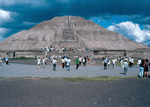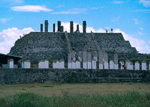
Toltec Notes
900 – 1200
I. 900 CE
At the fall of Teotihuacan, Chichimeca people acquired Teotihuacan and became the Toltecs (tolteca), who made their capital at Tula, north of Teotihuacan. The Chichimeca-Toltec people was principally aggressive and warlike, and they were not known for elaborate art and/or architecture. For a photo tour of Teotihuacan, click on the following image:
 |
|---|
II. 968 CE
In 968 a legendary man named Topiltzin Quetzalcóatl arrived at Tula. He seems to have been a bearded "white man". He is said to have been a bringer of civilization; he was opposed to human sacrifice; he tried to impose monotheism; and he became a priest-king. In 1000 he was exiled from Tula. In Tula he was worshipped as the demi-god Tlahuizcalpantlicuhtli, the god of wind and the god of the planet Venus (the morning star/evening star). The Toltecs adopted the cult of Topiltzin Quetzalcóatl. While the various peoples of Mesoamerica and the Mexican highlands (from Guatemala to north-central Mexico) had worshipped gods or legendary figures or demi-gods like Quetzalcóatl (Gucumatz, Kukulkán, etc.) the elaborated cult of Quetzalcóatl spread throughout Mesoamerica when this legendary man left Tula and went to the Yucatán.
III. Toltec humanities
Toltec architecture was majestic, geometric, and cubic with cylindrical masses. Toltec sculpture was anthropormorphic (man-centered), but it also featured friezes of eagles eating human hearts. Often Toltec walls are seen with human skulls implanted in them. One also sees monsters with a jaguar body and human heads. Especially notable are the warrior statues seen at Tula. Another notable feature of the Toltecs is that the 52-year cosmic/solar cycle was elaborated and first celebrated at Tula. For a photographic tour of Tula, click on the following image:
 |
|---|
IV. Post-Toltec period
The period of 1100 to about 1300 is a time of general chaos in Mesoamerica with no definitive cultural or military or political power center. In general it is a time when various cultures fuse with each other (i.e., indigenous synchretism). The Aztec/Mexica arrived near Tula in 1168 and adopted the 52-year cycle as the basis of their cosmic system.